BiomiMETRIC Assistance Tool: A Quantitative Performance Tool for Biomimetic Design
Abstract
:1. Introduction
2. Context and Terminology in Biomimetics
2.1. Functions and Strategies of Living Organisms
2.2. The Principles of Living Organisms to Formalize Biomimicry
- Use materials sparingly.
- Use energy efficiently.
- Do not exhaust resources.
- Source or buy locally.
- Optimize the whole rather than maximize each component individually.
- Do not pollute your nest.
- Remain in dynamic equilibrium with the biosphere.
- Use waste as a resource.
- Diversify and cooperate.
- Be informed and share information.
2.3. Biomimetic Principles from the Study of Living Organisms and Sustainable Ecosystems
2.4. Life-Cycle Assessment Method for Impact Evaluation
- -
- Method ReCiPe, which was revised in 2016 for use in life-cycle analysis [25,26], includes the impact categories of midpoint (problem-oriented) and endpoint (damage-oriented). The characterization factors (CF) of ReCiPe are given for the following 13 impact categories [25]: (1) Climate change. CF is the global warming potential based on the IPCC 2013 report. Unit: yr/kg CO2 equivalents; (2) stratospheric ozone depletion. CF accounts for the destruction of the stratospheric ozone layer by anthropogenic emissions of ozone depleting substances. Unit: yr/kg CFC-11 equivalents; (3) ionizing radiation. CF accounts for the level of exposure for the global population. Unit: yr/kBq Cobalt-60 equivalents to air; (4) fine particulate matter formation. CF is the intake fraction of PM2.5. Unit: yr/kg PM2.5 equivalents; (5)a photochemical ozone formation and human health. CF is determined from the change in the intake rate of ozone due to changes in the emission of precursors (NOx and non-methane VOC). Unit: yr/kg NOx eq; (5) b photochemical ozone formation and terrestrial ecosystems. CF is determined from the change in the intake rate of ozone due to changes in the emission of precursors (NOx and non-methane VOC). Unit: yr/kg NOx eq; (6) terrestrial acidification. CF is acidification potential (AP) derived using the emission weighted world average fate factor of SO2. Unit: yr/kg SO2 equivalents; (7) freshwater eutrophication. CF accounts for the environmental persistence (fate) of the emission of P (phosphorus)-containing nutrients. Unit: yr/kg P to freshwater equivalents; (8) marine eutrophization. CF accounts for the environmental persistence (fate) of the emission of N (nitrogen) containing nutrients. Unit: yr/kg N to marine equivalents; (9) ecotoxicity terrestrial, freshwater, marine, and human carcinogenic or human non-carcinogenic. The CF of human toxicity and ecotoxicity accounts for the environmental persistence (fate) and accumulation in the human food chain (exposure), and toxicity (effect) of a chemical. Unit: yr/kg 1,4-dichlorobenzeen (1,4-DCB) emitted. (10) water use. CF is the amount of fresh water consumption. Unit: m3 water consumed. For the moment, this impact category does not include regionalized characterization factors. The AWARE method is better to evaluate impact on water; (11) land use. CF is the amount of land transformed or occupied for a certain time. Unit: m2*yr; (12) mineral resource scarcity. CF is the surplus ore potential. The unit is kg copper (Cu) equivalents; (13) fossil resource scarcity: CF is the fossil fuel potential, based on the higher heating value. Unit: kg oil equivalents. The characterization factors are representative of the global scale.
- -
- Method CED [27] enables the evaluation and comparison of energy criteria for products and services. The primary energy demand and all energy carriers that are found in nature are calculated for the entire lifetime. CED is the sum of the cumulative energy demands for the production, use, and disposal of the product. This method was published by Ecoinvent, and it is widely used as a screening indicator for environmental impacts [28]. The CF [23] of the energy resources are divided into five impact categories: (1) Non-renewable, fossil (based on the upper heating value of the resources); (2) non-renewable, nuclear (based on the upper heating value of the resources); (3) renewable, biomass (based on the amount of energy harvested or converted); (4) renewable, wind, solar, and geothermal (amount of energy harvested or converted); 5) renewable, water (based on the amount of rotation energy transmitted to the turbine). The unit of CF is megajoule equivalent (MJ eq), and the method has a global location (no regionalization).
- -
- Method CExD. Exergy is a way to express the quality of energy rather than the context of energy. Exergy is a measure of the useful work that a certain energy carrier can offer. For instance, natural gas has a high exergy value, as it can be used to create high temperatures and highly pressured steam. In this method, exergy is used as a measure of the potential loss of useful energy resources. In order to quantify the life-cycle exergy demand of a product, the indicator cumulative exergy demand (CExD) is defined as the sum of exergy of all resources that are required to provide a process or product. [26]. The CF of the exergy resources are divided into 10 impact categories: (1) Non-renewable fossil; (2) non-renewable nuclear; (3) renewable kinetic; (4) renewable solar; (5) renewable potential; (6) non-renewable primary; (7) renewable biomass; (8) renewable water; (9) non-renewable metals; (10) non-renewable minerals. The unit of CF is megajoule equivalent (MJ eq).
- -
- Method AWARE [26] consists of the following: (1) A water-use indicator representing the relative available water remaining (AWARE) per area in a watershed after the demand of humans and aquatic ecosystems has been met; (2) the recommended method from WULCA (i.e., a working group under the umbrella of the UNEP-SETAC Life Cycle Initiative) to assess water consumption impact in LCA. It is used to assess the potential of water deprivation in either humans or ecosystems (the less the available water remaining per area, the more likely it is that another user will be deprived). The AWARE indicator is calculated in two steps: (1) Relative to the area (m3/m2·month), the AWARE indicator (availability minus demand [AMD]) of humans and aquatic ecosystems; (2) the value is normalized with the world average result (AMD = 0.0136 m3/m2·month) and inverted. The result represents the relative value in comparison with the average m3 consumed in the world. The world average is calculated as a consumption-weighted average. The AWARE indicator is non-dimensional and ranges from 0.1 to 100, where 0.1 is the best target. A value of 1 is the world average; a value of 10 describes a region where there is 10 times less available water remaining per area than the world average.
- -
- Method IPCC 2013, which was developed by the International Panel on Climate Change (IPCC), lists the climate change factors with a timeframe between 20 and 100 years. This method is the most frequently recommended for GHG evaluation, and IPCC is used in many other methods. Direct global warming potentials (GWPs) are an index for indicating the impact of carbon dioxide and estimating the relative global warming contribution of a kg of a particular GHG compared to the emission of a kg of CO2 [28]. The characterization factors of IPCC, expressed in kg CO2 eq, are available in table based on a 100-year time horizon [29].
- -
- USEtox2 [26,30] is an environmental model for the characterization of human and ecotoxicological impacts. This method is designed to describe the fate, exposure, and effects of chemicals. It is officially recommended as an assessment method by the European Commission, the World Business Council for Sustainable Development, and by the United States EPA. The CF [31] are as follows: (1) Human toxicity potential, where CF is expressed in comparative toxic units (CTUh), providing the estimated increase in morbidity in the total human population per unit mass of a contaminant emitted and assuming equal weighting between cancer and non-cancer effects. Unit: Disease cumulative cases/kg; (2) ecotoxicity potential. The ecotoxicological effect reflects the potentially affected fraction (PAF) of species. Unit: PAF m3 kg−1. The CF is representative of the global scale.
3. Methodological Approach
3.1. Dimensions of Biomimetic Eco-Innovation
- Efficiency and frugality: This dimension includes the principles of “Using materials and energy sparingly and effectively,” “Source or buy locally,” “Do not exhaust resources,” and “Optimizing the whole rather than maximizing each component individually.” Efficiency is associated with frugality in resource consumption.
- Preservation and resilience: This dimension includes the principles of “Do not pollute your nest” and “Remain in dynamic equilibrium with the biosphere.” Preservation is associated with resilience, which ensures that nature adapts to change.
- Circularity and systemic approach: This dimension includes the principles of “Use waste as a resource,” “Diversify and cooperate,” and “Be informed, share information, and implement feedback loops.” Circularity is associated with the systemic approach based on the analysis of flows into and out of the system boundaries.
3.2. Association of Environmental Impact Assessment Methods Used in LCA with the Principles of Living Organisms which Guide the Biomimetic Design
- ❖
- The efficiency and frugality dimension includes the five biomimicry principles described in detail below. Efficiency is associated with frugality in resource consumption. Each impact method that is proposed to analyse a principle is also presented.
- Use materials sparingly. This principle is proposed to reduce the quantities of materials and ores used. For this principle, we will use the ReCiPe method [25] to evaluate the consumption-mineral resource scarcity. The other impact categories of the ReCiPe method previously presented will be used to quantify other biomimetic principles or “Life’s Principles”.
- Use energy efficiently. This principle is proposed to maximize the efficiency of the energy conversion systems used, especially in the case of non-renewable resources and energy of mineral resources with the impact category or characterization factor, 12y. For this principle, we use the cumulative energy demand (CED) method to estimate the amount of energy used.
- Do not exhaust resources. This principle invites us to focus on abundant, renewable, and easily accessible resources and to be aware of resource limitations or renewal rates. For this principle, we use the cumulative exergy demand (CExD) method to assess the quality degradation of the energy used. We will also use the ReCiPe method [25,26], which was presented above, to assess fossil resource consumption using the 13 Fossil resource scarcity impact category. For this principle, we also recommend the AWARE method for assessing the impacts on water availability [35]. Many impact analysis methods, such as ReCiPe, do not sufficiently consider the impact of water consumption on its availability and on human health [36].
- Source or buy locally. This principle concerns the reduction of the impact of transport, especially in terms of GHG emissions. We use the IPCC 2013 GWP 100a method to assess emissions in kg CO2 eq.
- Optimize the whole rather than maximize each component individually. The objective of this principle is to define optimization or quality according to the principles of sustainable development. No impact quantification method is applicable to this principle. To evaluate it, in biomiMETRIC, we formulate the series of five questions presented below, which are evaluated and weighted according to their level of consideration in the product or solution. The higher the score, the more strongly the question is considered from the point of view of the implementation of biomimicry in the product or the design.
- Are repair, repackaging, dismantling, and recycling at the end of life possible?
- Is the quantity of residual materials reduced?
- Are the product and production aimed to respect the environmental support capacity?
- Do the product and production reduce environmental impacts?
- Is an ecolabel or environmental product declaration being sought?
- ❖
- The preservation and resilience dimension includes the principles presented below. Preservation is associated with resilience, which ensures that nature adapts to change because it is consistent with the principles:
- 6.
- Do not contaminate your nest. This principle invites us to use green chemistry with low environmental impacts and to avoid the generation of pollutants. For this principle, we use the ReCiPe method [25,26] presented above to evaluate GHG emissions with the characterization factor 1, climate change, the depletion of the ozone layer with the characterization factor 2, stratospheric ozone depletion, the assessment of fine particulate matter emissions PM 2.5, PM 10 with characterization factor 4, fine particulate matter formation, and the formation of photochemical smog with characterization factor 5, photochemical ozone formation.
- 7.
- Remain in dynamic equilibrium with the biosphere. This principle invites us to minimize environmental impacts so that the capacity of the biosphere is not degraded in supporting life. For this principle, we use the ReCiPe method [25,26] presented above to evaluate the acidification of the environment with characterization factor 6, terrestrial acidification, the eutrophication of fresh water and oceans with the characterization factors 7, freshwater eutrophication and 8, marine eutrophication, human toxicity and aquatic and terrestrial ecotoxicity with characterization factor 9, ecotoxicity terrestrial, freshwater, marine, and human carcinogenic or human non-carcinogenic.
- ❖
- The circularity and systemic dimension includes the principles presented below. These principles are qualitative and cannot be quantified using impact methods in LCA. To overcome this problem, we will develop a series of questions and a scorecard to quantify the performance of a solution regarding the principles of biomimicry.
- 8.
- Use waste as a resource. This principle invites us to close the loop in a circular economic logic. To evaluate this principle, we use the ReCiPe method [25,26] presented above to quantify land use with the characterization factor 11, land use. A closure of flows and a reduction in the amount of waste will reduce the demand for ground space to ensure the supply of resources and waste management.
- 9.
- Diversify and cooperate. This principle invites us to implement the circular economy. No impact quantification method is applicable to this principle. To evaluate it, we use in biomiMETRIC the series of five questions presented below, which are evaluated and weighted according to the level of consideration of the questions in the product or solution. The higher the score, the more strongly the question is considered from the point of view of the implementation of biomimicry in the product.
- Are functional economy (or cooperation economy) tools known and used?
- Can the project be positioned in a non-competitive niche to avoid competition?
- Have stakeholders been identified and consulted during the project?
- Is the systemic approach used?
- Are circular economy principles known and applied?
- 10.
- Be informed, share information, and implement feedback loops. This principle invites us to adopt a systemic vision. Circularity is associated with the systemic approach based on the analysis of flows into and out of the system boundaries. Living organisms receive and process a great amount of information to adapt to variations in their environment (e.g., temperature, season, and light). For this principle, we also formulate a series of five questions presented below.
- Is the information required to increase sustainability disseminated and accessible?
- Are training and evaluation on the biomimetic approach proposed?
- Does the company integrate social and environmental information in its decision-making?
- Is a special attention paid to scarce and over-exploited resources?
- Are the major issues related to sustainability and societal inequalities known and shared?
3.3. Development of BiomiMETRIC Assistance Tool for Biomimetic Design
- Weight the question according to its importance in the context of the project. The weighting is on a scale of 1 to 5, and it serves as a calibration of the weight that is given to the question in the context. A weighting of 1 means that it is desirable for the question to be considered, and a weighting of 3 indicates that the question is necessary, whereas a level 5 indicates the indispensable need to consider the question.
- Evaluating the question is equivalent to assigning a score that is (−−), (−), 0, (+) or (++), depending on how the project, concept, or product answers the question.
- Subsequently, according to the weighting and evaluation of the question, a score between −2 and 2 is granted according to the values presented in the matrix shown in Table 2.
4. Results
4.1. Procedure for Using BiomiMETRIC
- Select the impact assessment methods recommended in the tool for each biomimetic principle. The methods used are those presented: ReCiPe, USEtox2, IPCC 2013, AWARE, CED, and CExD. Evaluate each impact category and record the results associated with each biomimetic principle presented in the tool (one principle per tab in the spreadsheet).
- For each biomimetic principle, in addition to the results of the LCA methods, evaluate the questions asked using the evaluation and weighting grid available in BiomiMETRIC. A quantitative value will then be calculated by BiomiMETRIC based on the level of integration of the questions asked in the project, the concept, the product, or the design.
- Repeat the sequence for scenario B, and compare its performance with scenario A.
- After recording the results of the LCA for the two scenarios A and B to be compared, evaluate the questions on the 10 “Life’s Principles:
- (a)
- Open the quantitative results Table. This sheet will present a summary of the results and the scenario that best meets the biomimetic principles.
- (b)
- Open the quantitative results graphs tab, where the compared results of the two scenarios are presented in graphical form.
- (c)
- Open the qualitative results Table. This sheet will present a performance evaluation based on the answers to the qualitative questions about the biomimetic approach implemented in the project. In this section, there is no comparison between the scenarios A and B, as we consider that the general principles evaluated by the questions will be implemented in a similar way regardless of the scenario chosen. The sheet also presents the biomimetic principles for which corrective action is required.
4.2. Using BiomiMETRIC: An Illustration
5. Discussion
6. Conclusions
Author Contributions
Funding
Conflicts of Interest
References
- ISO. Organisation Internationale de Normalisation ISO 18458-Biomimétique—Terminologie, Concepts et Méthodologie. 2015. Available online: https://www.iso.org/fr/standard/62500.html (accessed on 12 October 2017).
- Biomicry-Institut. Méthode de Design Biomimétique 2016. Available online: http://toolbox.biomimicry.org/methods/ (accessed on 16 June 2019).
- Benyus, J.M. Biomimétisme–Quand la Nature Inspire des Innovations Durables; Rue de l’échiquier: Paris, France, 2011; p. 407. [Google Scholar]
- De Pauw, I.; Kandachar, P.; Karana, E. Assessing sustainability in nature-inspired design. Int. J. Sustain. Eng. 2015, 8, 5–13. [Google Scholar] [CrossRef]
- Earthshiftglobal. Webminar: Life Cycle Assessment (LCA) & Biomimicry. 2019. Available online: https://www.earthshiftglobal.com/brownbag#Biomimicry (accessed on 25 April 2019).
- Ask-Nature. Ask Nature Data Base. 2015. Available online: http://www.asknature.org/ (accessed on 16 June 2019).
- Terrier, P.; Glaus, M.; Raufflet, E. Biomimétisme: Outils pour une démarche écoinnovante en ingénierie. Available online: http://journals.openedition.org/vertigo/17914 (accessed on 16 June 2019).
- Chayaamor-Heil, N.; Guéna, F.; Hannachi-Belkadi, N. Biomimétisme en architecture: État, méthodes et outils. Les Cahiers de la Recherche Architecturale Urbaine et paysagère 2018, 1. [Google Scholar] [CrossRef]
- Wanieck, K.; Fayemi, P.; Maranzana, N.; Zollfrank, C.; Jacobs, S. Biomimetics and its tools. Bioinspired Biomim. Nanobiomater. 2017, 6, 53–66. [Google Scholar] [CrossRef] [Green Version]
- Chakrabarti, A.; Siddharth, L.; Dinakar, M.; Panda, N.; Keshwani, S. Idea Inspire 3.0—A tool for analogical design. In International Conference on Research into Design; Springer: Berlin/Heidelberg, Germany, 2017. [Google Scholar]
- Kruiper, R.; Vincent, J.F.V.; Abraham, E.; Soar, R.C.; Konstas, L.; Chen–Burger, J.; Desmulliez, M.P.Y. Towards a design process for computer-aided biomimetics. Biomimetics 2018, 3, 14. [Google Scholar] [CrossRef] [PubMed]
- Vincent, J.F. The trade-off: A central concept for biomimetics. Bioinspired Biomim. Nanobiomaterials 2016, 6, 67–76. [Google Scholar] [CrossRef]
- Lenau, T.A. Biomimetics as a design methodology-possibilities and challenges. In Proceedings of the DS 58-5: The 17th International Conference on Engineering Design (ICED ’09), Palo Alto, CA, USA, 24–27 August 2009; Volume 5. [Google Scholar]
- Principle-Biomicry-Institut. Principle of Life. 2012. Available online: https://biomimicry.net/the-buzz/resources/designlens-lifes-principles/ (accessed on 16 June 2019).
- Frischknecht, R.; Rebitzer, G. The ecoinvent database system: A comprehensive web-based LCA database. J. Clean. Prod. 2005, 13, 1337–1343. [Google Scholar] [CrossRef]
- Weidema, B.P.; Bauer, C.; Hischier, R.; Mutel, C.; Nemecek, T.; Reinhard, J.; Vadenbo, C.O.; Wernet, G. Overview and Methodology: Data Quality Guideline for the Ecoinvent Database Version 3; Swiss Centre for Life Cycle Inventories: Edinburgh, UK, 2013. [Google Scholar]
- Biomicry-Institut. Taxonomy du Biomimétisme. Découvrir les Fonctions de la Nature. 2017. Available online: https://asknature.org/resource/biomimicry-taxonomy/#.V__ZTrczX_U (accessed on 29 May 2018).
- Biomicry-Institut. Nature’s Unifying Patterns 2015. Available online: http://biotoolbox.wpengine.com/wp-content/uploads/2015/04/NUPs-Examples-PDF.pdf (accessed on 29 May 2018).
- Thompson, I.; Mackey, B.; McNulty, S.; Mosseler, A. Forest Resilience, Biodiversity, and Climate Change. A Synthesis of the Biodiversity/Resilience/Stability Relationship in Forest Ecosystems; Secrétariat de la Convention sur la Diversité Biologique: Montréal, QC, Canada, 2009; pp. 43, 67. [Google Scholar]
- Thompson, I.D.; Okabe, K.; Tylianakis, J.M.; Kumar, P.; Brockerhoff, E.G.; Schellhorn, N.A.; Parrotta, J.A.; Nasi, R. Forest biodiversity and the delivery of ecosystem goods and services: Translating science into policy. BioScience 2011, 61, 972–981. [Google Scholar] [CrossRef]
- Bear, R.; Rintoul, D.; Snyder, B.; Smith-Caldas, M.; Herren, C.; Horne, E. Principles of Biology. Available online: http://cnx.org/contents/db89c8f8-a27c-4685-ad2a-19d11a2a7e2e@24.18 (accessed on 9 July 2019).
- Handbook, I. Recommendations for Life Cycle Impact Assessment in the European Context; Publications Office of the European Union: Luxemburg, 2011. [Google Scholar]
- PRé-Consultants. SimaPro Database Manual Methods Library. 2018, p. 65. Available online: https://www.pre-sustainability.com/download/manuals/DatabaseManualMethods.pdf (accessed on 9 July 2019).
- Thériault, N. Dans le cadre d’une ACV, conception d’un outil d’aide à la sélection d’un jeu de catégories d’impact pour les entreprises européennes et Nord.-Américaines du secteur textile; Centre Universitaire de Formation en Environnement de l’Université de Sherbrooke: Sherbrooke, QC, Canada, 2011. [Google Scholar]
- Huijbregts, M.; Steinmann, Z.; Elshout, P.; Stam, G.; Verones, F.; Vieira, M.; Hollander, A.; Zijp, M.; van Zelm, R. ReCiPe 2016: A Harmonized Life Cycle Impact Assessment Method at Midpoint and Endpoint Level Report I: Characterization; Springer: Berlin/Heidelberg, Germany, 2016. [Google Scholar] [CrossRef]
- Pré-Sustainability. SimaPro Database Manual Methods Library; Pré Sustainability: Amersfoort, The Netherlands, 2016. [Google Scholar]
- Mert, G.; Linke, B.; Aurich, J. Analysing the cumulative energy demand of product-service systems for wind turbines. Procedia CIRP 2017, 59, 214–219. [Google Scholar] [CrossRef]
- Frischknecht, R.; Jungbluth, N.; Althaus, H.-J.; Hischier, R.; Doka, G.; Bauer, C.; Dones, R.; Nemecek, T.; Hellweg, S.; Humbert, S. Implementation of Life Cycle Impact Assessment Methods; Data V2.0, Ecoinvent Report No. 3; Ecoinvent Centre: Zurich, Switzerland, 2007. [Google Scholar]
- GHG-Protocol. Global Warming Potential Values; World Resources Institute: Washington, DC, USA, 2015; Available online: https://ghgprotocol.org/sites/default/files/Global-Warming-Potential-Values%20%28Feb%2016%202016%29_1.pdf (accessed on 16 June 2019).
- USEtox-Team. A Scientific Model for Characterizing Human and Ecotoxicological Impacts of Chemicals. Available online: https://www.usetox.org/ (accessed on 9 July 2019).
- Fantke, P.; Bijster, M.; Guignard, C.; Hauschild, M.; Huijbregts, M.; Jolliet, O.; Kounina, A.; Magaud, V.; Margni, M.; McKone, T.; et al. USEtox® 2.0 Documentation, version 1.00; Technical University of Denmark: Kongens Lyngby, Denmark, 2017. [Google Scholar]
- OpenLCA. Open Source and Free Software for Sustainability and Life Cycle Analysis. 2018. Available online: http://www.openlca.org/ (accessed on 11 October 2018).
- NexusOpenLCA. Source of LCA Data Sets. 2018. Available online: https://nexus.openlca.org/ (accessed on 11 October 2018).
- Goedkoop, M.; Oele, M.; De Schryver, A.; Vieira, M.; Hegger, S. SimaPro Database Manual Methods Library; PRé Consultants: Amersfoort, The Netherlands, 2008; pp. 22–25. [Google Scholar]
- WULCA Working Group. Available Water REmaining 2015. Available online: http://www.wulca-waterlca.org/aware.html (accessed on 14 February 2019).
- Bulle, C.; Margni, M.; Patouillard, L.; Boulay, A.M.; Bourgault, G.; Bruille, V.D.; Cao, V.; Hauschild, M.; Henderson, A.; Humbert, S.; et al. IMPACT World+: A globally regionalized life cycle impact assessment method. Int. J. Life Cycle Assess. 2018, 1–22. [Google Scholar] [CrossRef]
- USEtox-2.0-Method. Characterizing Human and Ecotoxicological Impacts of Chemicals. 2018. Available online: https://www.usetox.org/ (accessed on 14 February 2019).
- Tout-sur-isolation. Laine de Roche. Available online: https://www.toutsurlisolation.com/Choisir-son-isolant/Les-isolants/Isolants-en-laine-minerale/Laine-de-roche (accessed on 7 April 2019).
- Natural21. Fiche Technique Panneau de Liege. Available online: http://www.naturel21.com/upload/file/telechargement/fiche%20technique%20liege%20panneau%20et%20vrac.pdf (accessed on 7 April 2019).
- Baines, T.S.; Lightfoot, H.W.; Evans, S.; Neely, A.; Greenough, R.; Peppard, J.; Roy, R.; Shehab, E.; Braganza, A.; Tiwari, A.; et al. State-of-the-art in product-service systems. Proceedings of the Institution of Mechanical Engineers, Part, B. J. Eng. Manuf. 2007, 221, 1543–1552. [Google Scholar] [CrossRef]
- Hauschild, M.Z.; Huijbregts, M.A. Introducing Life Cycle Impact Assessment; Springer: Berlin, Germany, 2015; pp. 1–16. [Google Scholar]
- Bare, J.C. TRACI: The tool for the reduction and assessment of chemical and other environmental impacts. J. Ind. Ecol. 2002, 6, 49–78. [Google Scholar] [CrossRef]
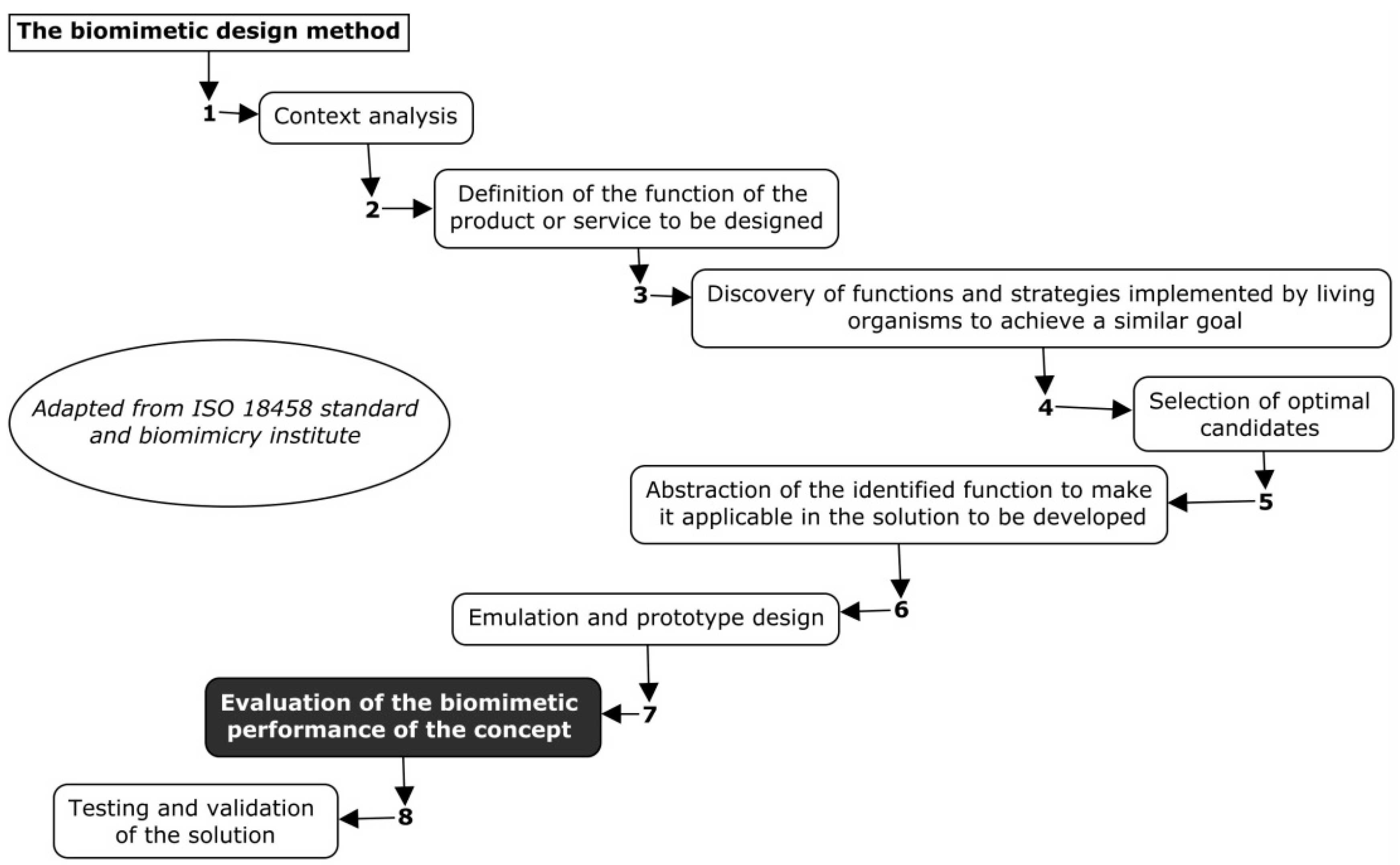
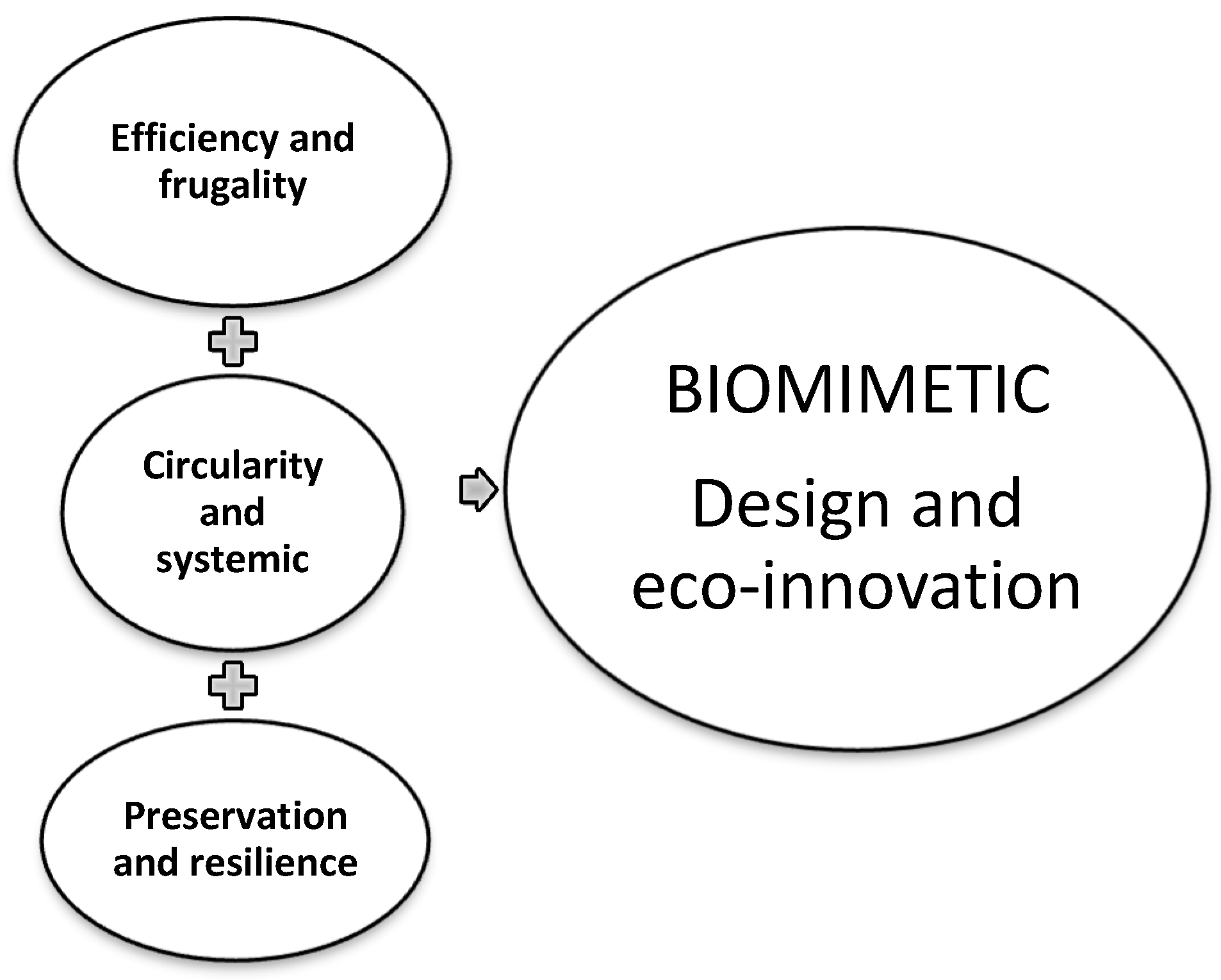
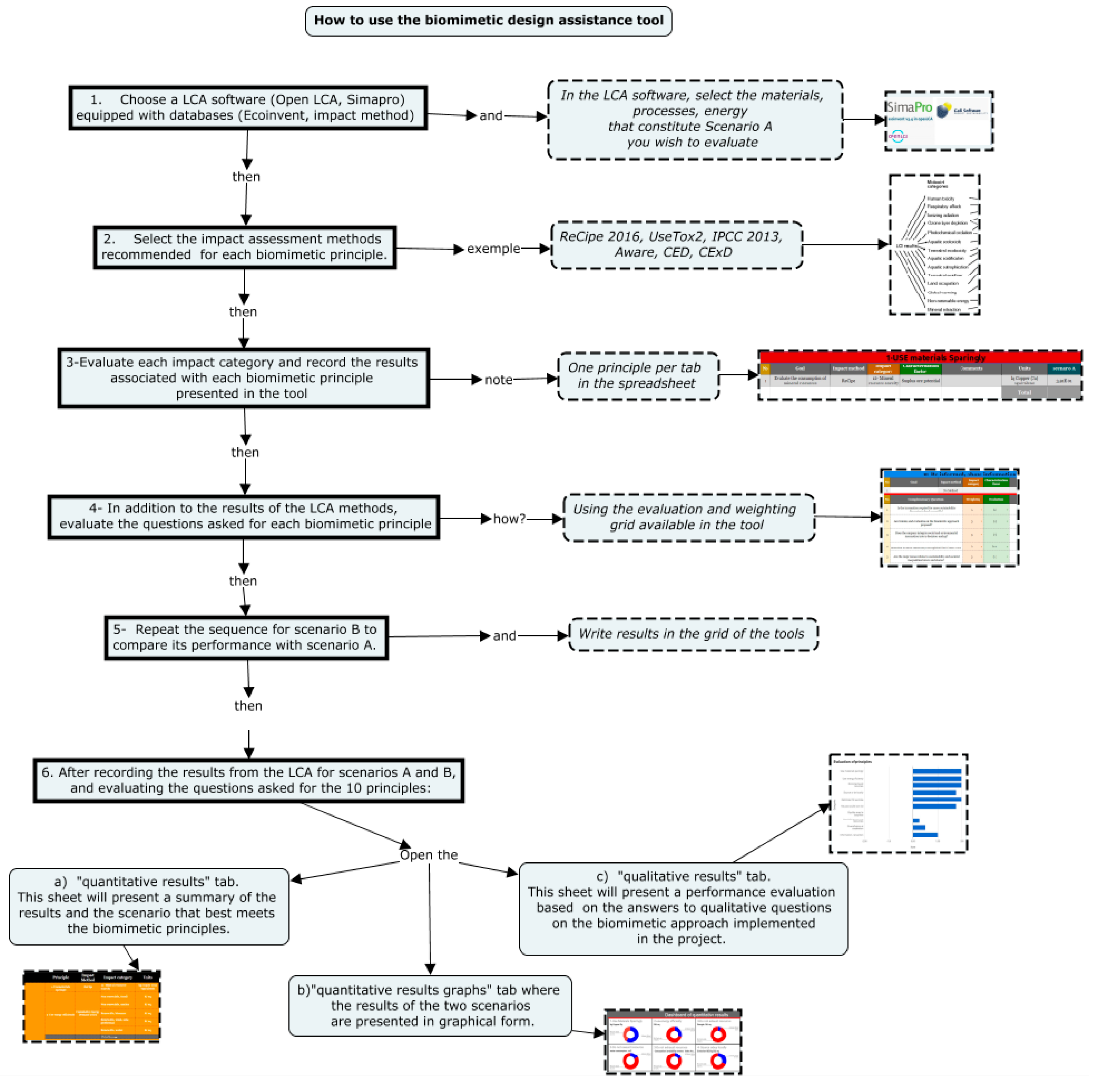
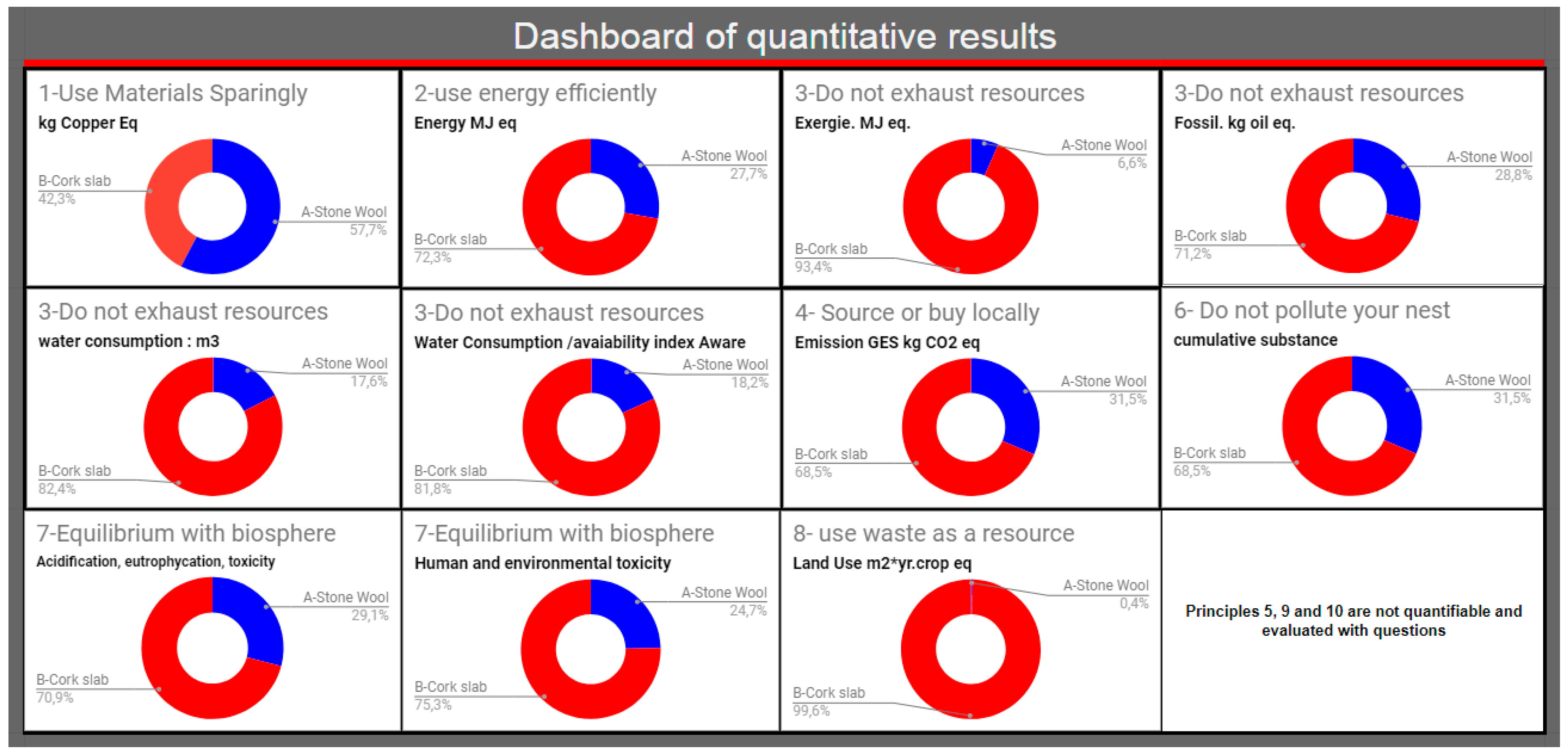
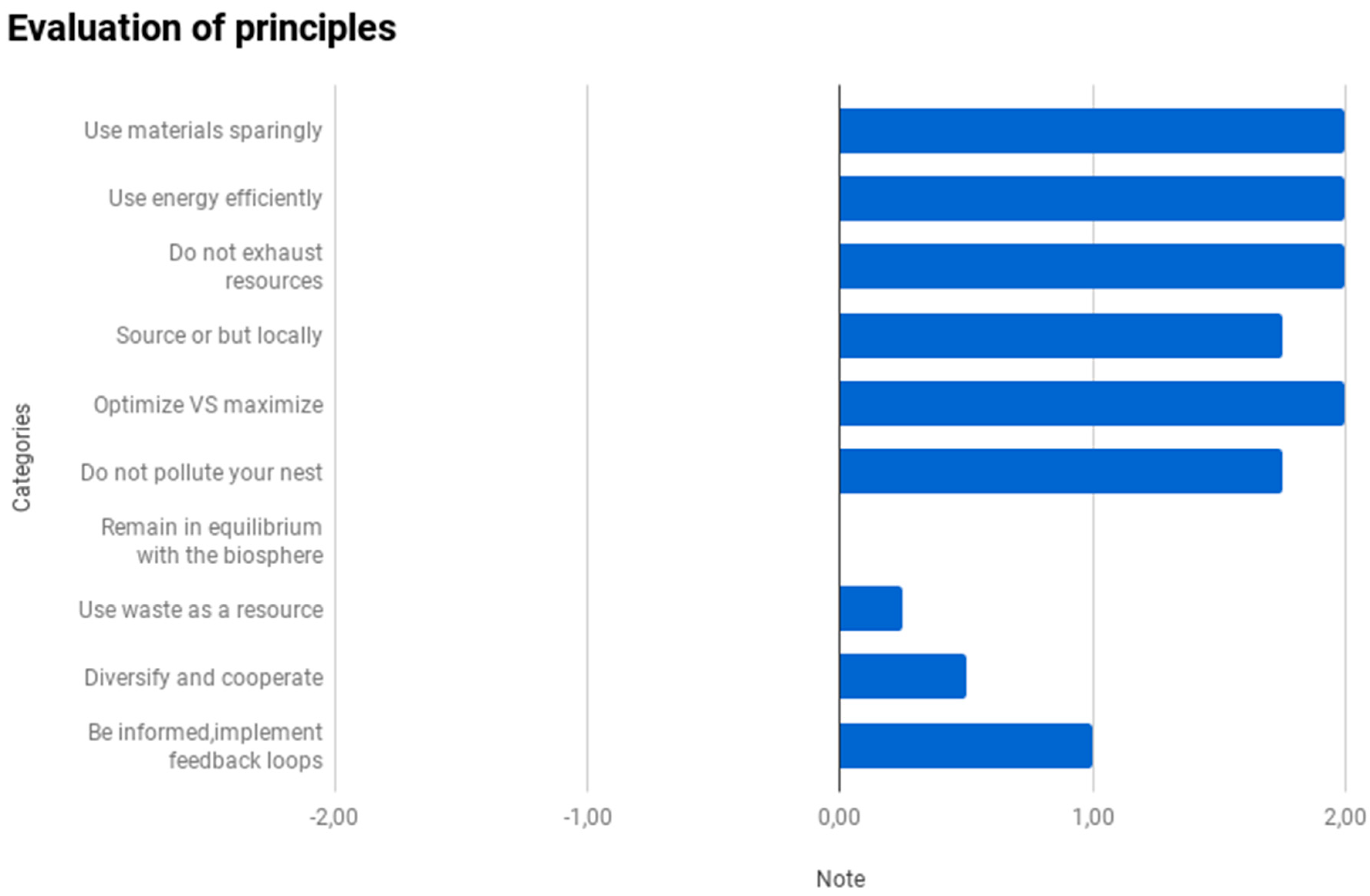
| Biomimetic Dimensions and Principles | LCA Approach | ||||
|---|---|---|---|---|---|
| Method | Impact Category | Information | Unit | ||
| Efficiency and frugality | |||||
| 1 | Use materials sparingly | ReCIPe | 12 - Mineral resource scarcity | Consumption of mineral resources | kg Cu eq |
| 2 | Use energy efficiently | Cumulative Energy Demand | Amount of energy used | Energy consumption | MJ eq |
| 3 | Do not exhaust resources | Cumulative Exergy Demand | Total exergy removal from nature. Quality degradation of the energy used | Sum of exergy of all resources required to provide a process or product. | MJ eq |
| ReCIPe | 13 - Fossil resource scarcity | Fossil resource consumption | kg oil eq | ||
| AWARE | Relative Available WAter REmaining per area in a watershed after the demand (humans & ecosystems) has been met | Impacts on water availability | Index: range [0.1;100] | ||
| 4 | Source or buy localy | IPCC 2013 GWP 100a | GHG emissions | Global warming potential of air emissions | kg CO2 eq |
| 5 | Optimize the whole rather than maximize each component individually | Specific questions | 5 questions evaluated and weighted according to their level of consideration in the product | Optimization or quality according to the principles of sustainable development | According to the weighting and evaluation of the question, a score between −2 and 2 is granted |
| Preservation and resilience | |||||
| 6 | Do not contaminate your nest | ReCIPe | 1 - Climate changes | Global warming potential of pollutants | kg CO2 eq |
| 2 - Stratospheric ozone depletion | Destruction of the stratospheric ozone layer | kg CFC-11 eq | |||
| 4 - Fine particulate matter formation | PM 2.5 in air emissions | kg PM2.5 eq | |||
| 5 - Photochemical ozone formation | Change in intake rate of ozone due to change in emission of precursors (NOx and NMVOC) | kg NOx eq | |||
| 7 | Remain in dynamic equilibrium with the biosphere | ReCIPe | 6 - Terrestrial acidification | Acidification Potential | kg SO2 eq |
| 7 - Freshwater eutrophication | Emission of P(phosphore) | kg P to freshwater | |||
| 8 - Marine eutrophication | Emission of N (nitrogen) | kg N to marine water | |||
| 9 - Ecotoxicity Terrestrial, Freshwater, Marine and Human carcinogenic or Human non-carcinogenic | Ecotoxicity accounts for the environmental persistence and accumulation in the human food chain | kg 1,4-dichlorobenzeen (1,4-DCB) | |||
| USEtox2 | Human toxicity potential | Estimated increase in morbidity in the total human population per unit mass of a contaminant emitted | Disease cumulative cases / kg substance | ||
| Ecotoxicity potential | Potentially Affected Fraction (PAF) of species | PAF m3 kg−1 | |||
| Circularity and systemic | |||||
| 8 | Use waste as a resource | ReCIPe | 11 - Land Use | Amount of land transformed or occupied for a certain time | m2*yr. crop eq |
| 9 | Diversify and cooperate | Specific questions | 5 questions evaluated and weighted according to their level of consideration in the product | Implement the circular economy | According to the weighting and evaluation of the question, a score between −2 and 2 is granted |
| 10 | Be informed, share information and implement feedback loops | Specific questions | 5 questions evaluated and weighted according to their level of consideration in the product | Adopt a systemic vision | According to the weighting and evaluation of the question, a score between −2 and 2 is granted |
| Evaluation | |||||||
|---|---|---|---|---|---|---|---|
| S/O | (−−) | (−) | (0) | (+) | (++) | ||
| weighting | S/O | 0 | 0 | 0 | 0 | 0 | 0 |
| 1 | 0 | 0 | 0 | 0 | 0.2 | 0.4 | |
| 2 | 0 | −0.25 | −0.1 | 0.25 | 0.6 | 0.8 | |
| 3 | 0 | −0.5 | −0.3 | −0.1 | 0.9 | 1.2 | |
| 4 | 0 | −1.5 | −1 | −0.5 | 1.35 | 1.6 | |
| 5 | 0 | −2 | −1.5 | −1 | 1.7 | 2 | |
| Material | Coefficient of Thermal Resistance R (m2 K/W) for 100 mm of Thickness | Density (kg/m3) | Mass Required to Insulate a 1 m3 Space |
|---|---|---|---|
| Stone wool (depending on quality) [38] | 2.7 | 70 | 70 |
| Cork panel (depending on quality) [39] | 2.7 | 110 | 110 |
© 2019 by the authors. Licensee MDPI, Basel, Switzerland. This article is an open access article distributed under the terms and conditions of the Creative Commons Attribution (CC BY) license (http://creativecommons.org/licenses/by/4.0/).
Share and Cite
Terrier, P.; Glaus, M.; Raufflet, E. BiomiMETRIC Assistance Tool: A Quantitative Performance Tool for Biomimetic Design. Biomimetics 2019, 4, 49. https://doi.org/10.3390/biomimetics4030049
Terrier P, Glaus M, Raufflet E. BiomiMETRIC Assistance Tool: A Quantitative Performance Tool for Biomimetic Design. Biomimetics. 2019; 4(3):49. https://doi.org/10.3390/biomimetics4030049
Chicago/Turabian StyleTerrier, Philippe, Mathias Glaus, and Emmanuel Raufflet. 2019. "BiomiMETRIC Assistance Tool: A Quantitative Performance Tool for Biomimetic Design" Biomimetics 4, no. 3: 49. https://doi.org/10.3390/biomimetics4030049
APA StyleTerrier, P., Glaus, M., & Raufflet, E. (2019). BiomiMETRIC Assistance Tool: A Quantitative Performance Tool for Biomimetic Design. Biomimetics, 4(3), 49. https://doi.org/10.3390/biomimetics4030049





